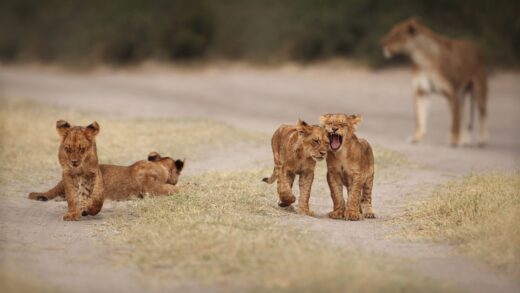Elephants, those magnificent creatures that grace our world with their immense presence, have long fascinated both scientists and nature enthusiasts. They are celebrated for their gentle nature, keen intelligence, and complex social structures. Yet, beneath the surface of their serene demeanor lies a fascinating enigma – the secrets of their behavior, particularly when their temper flares.
Much like us, humans, elephants are not immune to moments of agitation and even aggression. Understanding the triggers for these displays of temperament is crucial. It’s a journey through the intricacies of their social structure, the influence of the matriarchal figure, their unique modes of communication, the stressors they face in a changing world, and the role of human interference.
By peeling back the layers of this colossal mystery, we can gain a deeper appreciation for these gentle giants and work towards ensuring their well-being and harmonious coexistence with our species on this remarkable planet.
Secrets of Elephant Behavior
The secrets of elephant behavior are a fascinating glimpse into the intricate world of these majestic creatures. Unlike many other animals, elephants live in tightly-knit family units led by a matriarch, often the eldest and most experienced female in the group. This matriarchal structure plays a significant role in shaping the behavior of the herd, as she guides them in decisions about where to find food, water, and how to respond to potential threats.
Elephants communicate with one another through a variety of means, including vocalizations, intricate body language, and infrasound, a low-frequency sound that can travel long distances. This complex system of communication is essential for their social cohesion and survival. Stress factors, such as habitat loss and human encroachment, can trigger heightened levels of stress in elephants, potentially leading to aggressive behavior.
Furthermore, individual elephants have unique personalities, much like humans. Some may naturally be more prone to aggression, influenced by a combination of genetic and environmental factors. Human interference, in the form of poaching and habitat destruction, poses a grave threat to these gentle giants. Conservation efforts are crucial in protecting elephants and preserving their natural habitats, which, in turn, helps reduce instances of aggression brought about by human activities.
The secrets of elephant behavior offer a profound understanding of their world, shedding light on when and why these magnificent creatures may display temperamental behavior, and they emphasize the importance of coexisting harmoniously with these intelligent and sensitive animals.
Table of Contents
Understanding Elephant Behavior
Elephants are incredibly complex animals. Their behavior is shaped by various factors, including their environment, social dynamics, and even human interactions. Understanding these elements is key to comprehending when and why they may display aggressive behavior.
Social Structure of Elephants
Elephants live in intricate family units led by a matriarch. These social structures play a significant role in how they behave. Matriarchs, typically the oldest and most experienced females, are responsible for guiding the herd.
Triggers of Aggression
Aggression in elephants can be triggered by various factors, including competition for resources, territory disputes, or even protection of the herd. Knowing the potential triggers is vital to predicting and preventing aggressive outbursts.
Matriarchal Influence
The matriarchal role is crucial in maintaining order within the group. Her experience and wisdom guide the herd in making decisions about where to find food, water, and how to respond to potential threats. However, even matriarchs can lose their temper under certain circumstances.
Communication Among Elephants
Elephants communicate through vocalizations, body language, and infrasound—a low-frequency sound that can travel long distances. Understanding their methods of communication sheds light on their behavior and emotions.
Stress Factors
Stress is not unique to humans; elephants can also experience it. Changes in their environment, such as habitat loss or encroachment by humans, can lead to heightened stress levels and potentially aggressive behavior.
Role of Environmental Changes
Environmental changes, including those brought about by climate change, impact the behavior of elephants. As their natural habitats transform, they may become more irritable, seeking new sources of food and water.
Handling Aggression in Captivity
Elephants in captivity face unique challenges. Interactions with humans can influence their behavior significantly. Caretakers must be well-versed in elephant behavior to ensure the safety of both the animals and themselves.
Temperament Variation
Just like humans, elephants have individual personalities. Some may be naturally more aggressive than others, and these differences can be attributed to various genetic and environmental factors.
Impact of Human Interference
Human interference, such as poaching and habitat destruction, poses a significant threat to elephants. This interference can lead to stress, aggression, and even trauma among these magnificent creatures.
Conservation Efforts
Various organizations and conservationists are dedicated to protecting and preserving elephant populations. Their efforts not only help safeguard the elephants but also contribute to reducing instances of aggressive behavior caused by human activities.
Case Studies
Examining specific cases of elephant behavior and aggression can provide valuable insights into their complex psychology. We’ll explore some compelling examples from around the world.
Elephant Behavior and Climate Change
Climate change is an emerging threat to elephants. The altered landscape and weather patterns can disrupt their routine and trigger aggressive behavior.
In conclusion, understanding the secrets of elephant behavior and when their tempers flare is a multifaceted endeavor. By recognizing the influence of their social structures, communication methods, stress factors, and the impact of human interference, we can gain a deeper understanding of these remarkable creatures. As we work to conserve their natural habitats and protect their populations, we also aim to reduce instances of aggression and ensure a harmonious coexistence between elephants and humans.
Thank you, if you liked this information of mine then do give feedback. Your feedback will motivate me further so that I can give you more information.
Here is the some FAQs:
Frequently Asked Questions (FAQs)
- Are elephants really gentle giants? Yes, elephants are generally known for their gentle and intelligent nature, but they can become aggressive under certain circumstances.
- What role does the matriarch play in elephant behavior? The matriarch is the leader of the elephant herd and plays a pivotal role in guiding their behavior, especially in decision-making.
- How can we help elephants in the wild to reduce their aggression? Conservation efforts, such as protecting their natural habitats and combating poaching, are key to reducing aggression in wild elephants.
- Can climate change impact elephant behavior? Yes, climate change can disrupt the natural patterns of elephants, leading to changes in their behavior.
- Is captivity harmful to elephants’ behavior? Captivity can be stressful for elephants, and understanding their behavior is crucial to ensuring their well-being in such environments.




